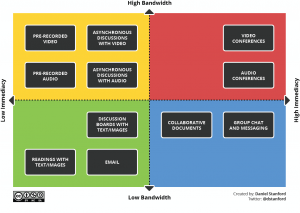Louise Creechan (GTA English Literature and Widening Participation, University of Glasgow)
Remote learning? Online delivery? Blended learning? F2F small group learning? Zoom? While universities are developing their own institutional policies with regard to socially-distant classroom spaces, it remains highly unlikely that we will be filling lecture theatres with 200+ students any time soon.
Deconstructing and Remodelling the Lecture
We are all familiar with the traditional lecture/seminar course model: several lectures (one or sometimes two hours long) presented to the full cohort of students registered on a particular course each week, supplemented by a small-group seminar of an hour or so per week. The essential component of this model – the lecture – has been the object of scrutiny for a long time in studies of HE pedagogy.
Since the 1980s, researchers have cast doubt on the extent that lectures promote deeper learning, arguing that the lecture is a mode of pedagogical practice that privileges certain types of learners, is too lengthy, unengaging, and stifles the development of autonomous thought. There are also accessibility issues that the traditional lecture format can struggle to accommodate. For example: fast-paced speech can make it more difficult for students with slower writing or processing speeds to take adequate notes and the focus on the voice of the lecturer over visual aids can make this medium more difficult for deaf students to follow.
As we move to remote learning, some of the deficiencies of the lecture model are exacerbated. Conducting synchronous live lectures over video conferencing software, such as Zoom or MS Teams, is problematic for the following reasons:
- High bandwidth required
- Difficult to provide real-time captions
- Requires high level of concentration over a sustained time period which is fatiguing
Source: Daniel Stamford, Videoconferencing Alternatives: How Low-Bandwidth Teaching Will Save Us All (https://www.iddblog.org/videoconferencing-alternatives-how-low-bandwidth-teaching-will-save-us-all/)
These are all significant access issues which need to be addressed from the outset of our course redesigns. The pandemic offers an opportunity to try out some new approaches.
So, what can we do to offer our students an accessible alternative?
- Divide your lecture into several smaller chunks – there is a long-standing consensus that attention tends to wander after around 10-15 minutes. While there is some debate about this, students will always appreciate having each sub-topic presented in a separate unit so they can find it more easily for review and revision.
- Pre-record small chunks and invite comments from students by posing a question at the end or asking them to look further into topic X and discuss their findings (e.g. on a discussion board). QUB has produced this useful guide to making accessible videos. (Remember that audio recordings, like podcasts, are another viable option.)
- Boost engagement with your materials through quizzes and discussion forums.
- Ask yourself whether you need to relay information to your students for them to achieve their intended learning outcomes. Could they learn by searching for information by themselves? This video from Dr Steven Mintz of the American Historical Association argues that ‘history is not a spectator sport’ and that the best way to learn history is to do history via source gathering ‘scavenger hunts’.
What alternatives can we offer our students? Is the pandemic an opportunity to rethink existing pedagogical models? Are lectures useful for remote learning?
We would love to hear your thoughts on how we remodel our lectures to take advantage of remote learning strategies. Please do get in touch with us on Twitter @history_uk to share your experiences.
Louise tweets at @LouiseCreechan

You must be logged in to post a comment.